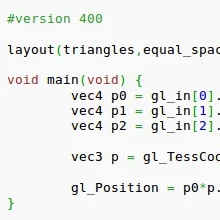Khronos ASTC: Royalty-Free Next-Gen Texture Compression

Adaptive Scalable Texture Compression, the ASTC LDR extension specification, is this new texture compression standard out of Khronos. ASTC is designed to be a "hightly flexible texture compression scheme" for both OpenGL and OpenGL ES. "ASTC is an exceptionally efficient compression technology which allows encoding of for a wide variety of texture formats at bit-rates of 8 bits per pixel to below 1 bit per pixel. ASTC is published as a Khronos extension, KHR_compressed_texture_astc_ldr...ASTC was developed under the cooperative process at Khronos and enables the size of textures images used in 3D games and applications to be significantly reduced while being downloaded and stored – saving memory size, access bandwidth and significantly reducing application size."
A Unity 3D engine developer says ASTC is "awesome!" and its texture compression is higher quality and lower bitrate than "any exisiting compression format", which does mean then it would be able to kick the ass of S3 Texture Compression. S3TC has been trouble for open-source Linux graphics drivers since it can't be integrated into Mesa and turned on by default over patent fears.
Below is the Khronos press release for ASTC. Hopefully we will see ASTC texture compression support appear in Mesa soon and that game and OpenGL developers begin using this next-generation texture compression scheme as soon as possible instead of S3TC.
Khronos Releases [ASTC] Next-Generation Texture Compression Specification
Content developers to benefit from smaller, lower bandwidth textures with higher quality and wider flexibility
August 6th, 2012 – Los Angeles, SIGGRAPH 2012 – The Khronos™ Group today announced the immediate release of the royalty-free, Adaptive Scalable Texture Compression (ASTC™) LDR extension specification, defining a new, highly flexible texture compression scheme for developers using both the OpenGL® ES and OpenGL® 3D graphics APIs. ASTC is an exceptionally efficient compression technology which allows encoding of for a wide variety of texture formats at bit-rates of 8 bits per pixel to below 1 bit per pixel. ASTC is published as a Khronos extension, KHR_compressed_texture_astc_ldr, which is available from t he Khronos website at http://www.khronos.org/registry/gles/.
“ASTC enables deep reductions in GPU memory bandwidth and application memory footprint,” said Tom Olson, chair of the OpenGL ES working group. “This new technology offers a huge step up in image quality compared to the leading existing formats.”
ASTC was developed under the cooperative process at Khronos and enables the size of textures images used in 3D games and applications to be significantly reduced while being downloaded and stored – saving memory size, access bandwidth and significantly reducing application size.
Aras Pranckevičius from game engine provider Unity 3D said: “ASTC is awesome! Texture compression that is higher quality, lower bitrate and with more control than any existing compression formats? Yes please!”
ASTC supports monochrome, luminance-alpha, RGB and RGBA formats, as well as X+Y and XY+Z formats for surface normals, and provides the flexibility for any format to be encoded at any bit rate. Uniquely, the encoding method is chosen independently for each block of pixels in the image, so that the coding adapts dynamically to most efficiently represent the image region-by-region. Advanced fractional-bit encoding and dynamic tradeoffs between the different types of data in each block means that ASTC outperforms all currently available texture compression schemes in image quality, and GPU power consumption, while processing compressed textures.
“We’re proud of ASTC and the benefits in reduced memory bandwidth and improved energy-efficiency that this innovative approach to compression will provide,” said Jem Davies, ARM Fellow and Vice President of Technology, Media Processing Division, ARM. “It will drive standardization and help accelerate visual computing for advanced applications across a wide range of consumer devices.”
“ASTC is a great step forward for the industry,” said Phil Rogers, AMD corporate fellow. “With ASTC we address several problems at once: support for advanced rendering techniques, reducing memory bandwidth and running at lower power. ASTC is a truly modern approach to texture compression, and we look forward to rapid and enthusiastic adoption.”
“Imagination has long been a leading developer of advanced texture compression technologies for mobile and embedded GPUs, so we applaud the technical achievements underpinning the new ASTC format. As a staunch supporter of open standards, in particular the Khronos family of APIs, we welcome ASTC as a true cross-platform state-of-the-art texture compression technology, whose creation is testimony to the collaborative abilities of Khronos,” said Tony King-Smith, vice president marketing, Imagination. “We are committed to adding ASTC to the extensive portfolio of texture compression standards supported by future PowerVR GPUs.”
“ASTC is the most important new standard in hardware texture compression technology in many years, satisfying developer demands for a high quality, highly compressed texture format with an alpha channel,” said Neil Trevett, vice president of mobile content at NVIDIA and president of the Khronos Group. “A universally supported compressed texture format will reduce authoring costs, and enable compact, unified 3D content to be transported and processed efficiently on diverse platforms, including mobile devices and a wide variety of WebGL-enabled browsers.”
33 Comments

